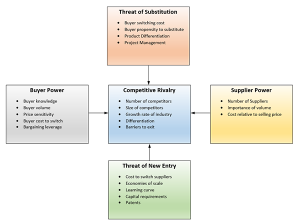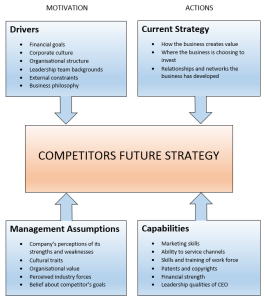
Corporate Strategy refers to the methods with which an organization achieves its goals. In the world of corporate strategy, the development of strategy is the third in a three step process, in this order:
- Corporate vision defines the state the organization wants to be in over the long term.
- Corporate goals define the metrics to which the company wishes to strive, based on its vision.
- Corporate strategy defines the means by which the organization will achieve those goals.
A Corporate Strategic Plan should be developed which summarizes and, where necessary, explains the strategies by which the organization will achieve its goals. With a clear picture of where it intends to go (goals) an organization performs a strategic analysis to determine its strategy. A strategic analysis consists of the following steps:
- PEST analysis
- Value chain analysis
- Five forces analysis
- Four corners analysis
- SWOT analysis
- War gaming
PEST Analysis
This is a great tool to quantify the external factors that affect an organization. Most of the time these are out of the control of the organization and thus represent an external risk that should be mitigated. The acronym PEST stands for:
- Political factors, such as government regulation, environmental and tax laws. If the organization does business across borders, political instability and trade restrictions fall under this category as well.
- Economic factors, such as economic growth rates in the countries where an organization is present, and market demand for a product. Inflation, interest rates, and currency exchange rates also fall under this category.
- Social factors include demographics, population growth, and changing attitudes toward certain products.
- Technological factors, such as changing technology that makes products obsolete or less competitive. Also, technological factors force investment in product upgrades or allow cost reductions within the production process.
Value Chain Analysis
This is an excellent tool which focuses on how activities within an organization create value for customers. It includes three steps:
- Divide the organization into primary activities (those that are directly involved in the production of goods or services) and secondary activities (everything else).
- Determine the cost of each activity.
- Identify which activities are the primary drivers of the success of the organization.
Five Forces Analysis

Michael Porter of Harvard Business School developed this technique in 1979. It’s a fairly simple way to analyze the competitive position of an organization.
Porter figured that there are five forces that essentially define the attractiveness of a market for the purposes of doing business. These five forces are:
- Supplier Power is a measure of the ability of suppliers to raise prices and take the competitive advantage away. This is dependent on the number of suppliers in the marketplace, as well as the uniqueness of their product or service and the difficulty in switching suppliers.
- Buyer Power is the measure of the ability of buyers to drive prices down. This is dependent on the number of buyers in the marketplace and the ability of the buyer to switch suppliers.
- Competitive Rivalry is a measure of the number of competitors in the market and their relative strength.
- Threat of Substitution is a measure of the number of ‘substitute products’ in the marketplace, which reduces the attractiveness whereby customers easily buy alternative, cheaper variations.
- Threat of New Entry is a measure of how easy it is to enter the market. Clearly, a high barrier to entry is preferable to a low one for established organizations. For those wishing to enter a new market, however, the opposite is true.
Four Corners Analysis
 This tool focuses on analyzing competitors to glean their potential future strategy. Things like:
This tool focuses on analyzing competitors to glean their potential future strategy. Things like:
- A competitor’s likely response to industry changes and external events that affect all companies in the industry.
- What a competitor might do in response to your strategy.
- What a competitor might do in the future.
The four components (corners) involved in the analysis are:
- Drivers: This involves an organization’s existing situation, for example, financial position and organizational structure, as well as factors such as corporate culture. It involves an attempt to determine what motivates the organization.
- Management Assumptions: Because a company’s actions are largely dictated by the assumptions they have about themselves, their competitors, and the industry, this is an important component of the analysis.
- Strategy: The organization’s current strategy. Where it is currently investing its profits, building relationships, and creating value.
- Capabilities: The organization’s strategy is also dependent on its abilities. Whether or not it has the technical or marketing ability to make new strategic moves will determine its future actions.
I hope this doesn’t sound too obvious, but one thing I can safely say about analyzing the competition is that when a strategy is working, one can assume they will not make in significant changes to their course.
SWOT Analysis
- Strengths: What an organization excels at. Unique selling propositions, competitive advantages, unique technical ability, and patents.
- Weaknesses: What an organization does not excel at.
- Opportunities: The moves an organization can make that are most likely to succeed. Technological, economic, social, or political opportunities, or gaps in market demand.
- Threats: Events that could potentially harm an organization. Technological, economic, social, or political threats. Competitive moves that impact the organization.
A SWOT analysis investigates each of these factors and plots them on a 2 x 2 matrix, like our example above.
War Gaming
War gaming is an attempt to replicate a strategic move in a no risk environment. A “team” is created for your organization and one competitor (or several). Each team gets a few members, but 2-4 is a good number. To be most effective, each team should have a diverse range of functional managers. There should also be a facilitator to oversee the contest and ensure that the strategies used are acceptable.
The ball is passed back and forth between the organization and its competitors, and each team considers and submits its next move. If the organization is holding the war game to analyze a potential strategic move, that is the natural first move.
As you can imagine, war gaming results in an intense analysis of the competitors next move, which is the intent. Once it is complete, everyone has a good idea of the strengths, weaknesses, and likely responses of the organization’s competitors. And this aids in decision making by the executive team.







